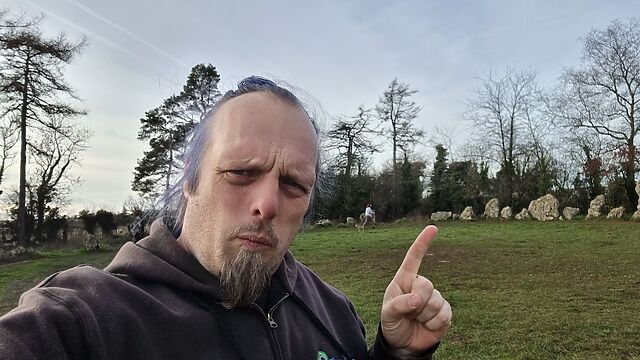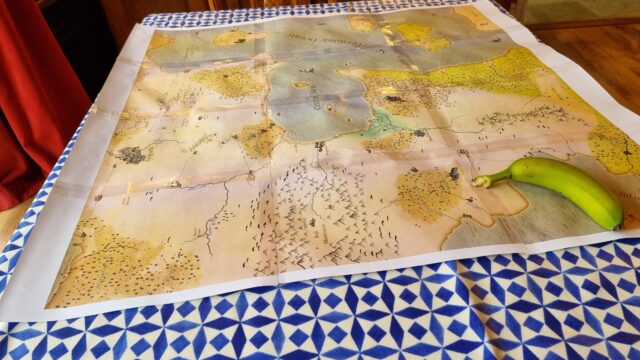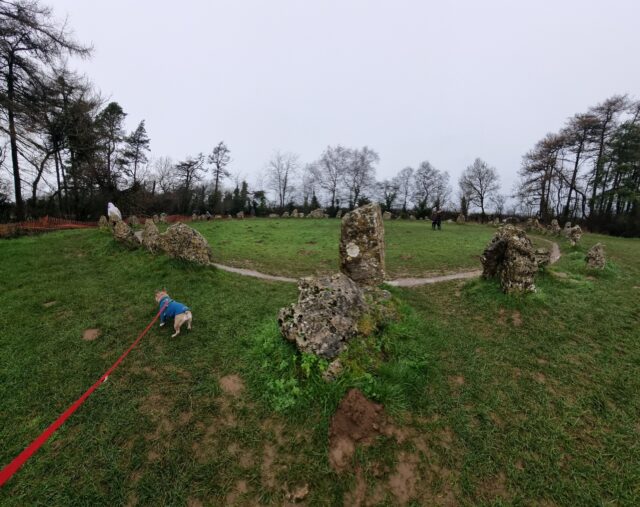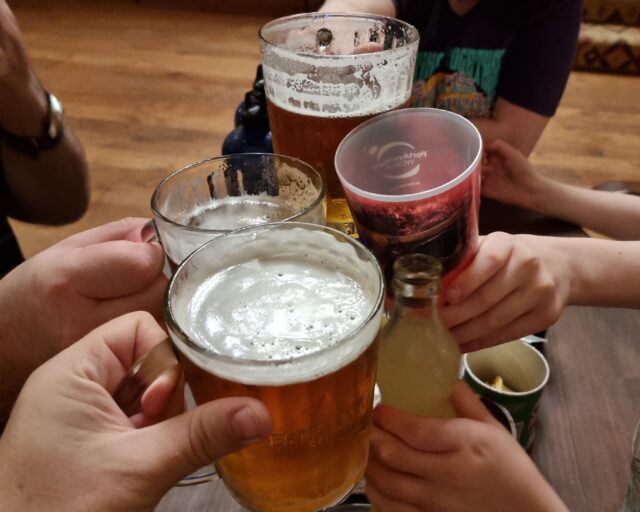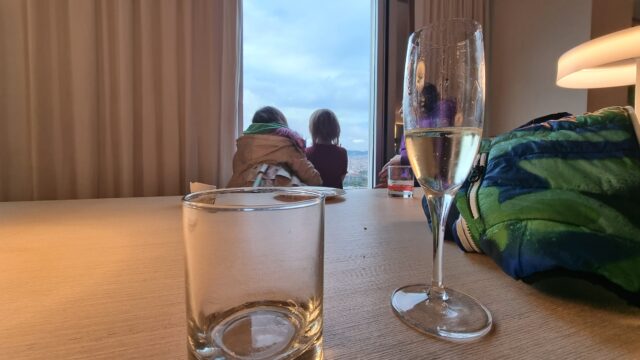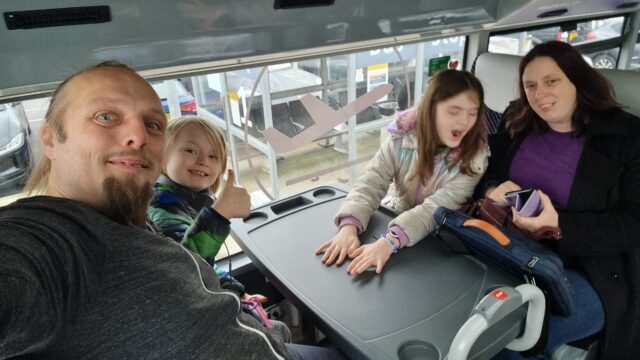Back at the Rollright Stones fire New Year’s Dsy, per family tradition. This year the younger child counted 74, the elder 59. The curse that prevents you counting the same number twice continues!
Tag: family
Happy Polyamory Day 2025
Happy Polyamory Day y’all. (Plus max props to Petra without whom I’d have forgotten about it, like most years.)
Closest thing I did to celebrating it was going out to the pub last night for beer and food with my metamour, while our partner-in-common took our kids to see a film. Polyfam life isn’t always glamorous; but it is full of love.
Family D&D’s Overworld Map
In preparation for Family D&D Night (and with thanks to my earlier guide to splicing maps together!), I’ve finally completed an expanded “overworld” map for our game world. So far, the kids have mostly hung around on the North coast of the Central Sea, but they’re picked up a hook that may take them all the way across to the other side… and beyond?
Banana for scale.
(If your GMing for kids, you probably already know this, but “feelies” go a long way. All the maps. All the scrolls. Maybe even some props. Go all in. They love it.)
Note #25428
Dan Q found GC34G3G Coventry – Hertford Street
This checkin to GC34G3G Coventry - Hertford Street reflects a geocaching.com log entry. See more of Dan's cache logs.
The rest of the family and I are visiting for my youngest’s birthday to do a handful of fun activities. Geocaching didn’t make the list, but that wasn’t gonna stop me finding this QEF while putting our swimming stuff back in the car before we eat our lunch. Thanks to the hint, this was in almost the first place I looked. TFTC, and greetings from Oxfordshire!
PortAventura
Melià Barcelona Sky
Note #24813
Shared Email Addresses
Email Antipatterns
There are two particular varieties of email address that I don’t often see, but I’ve been known to ridicule when I have:
-
Geographically-based personal email addresses, e.g.
OurHouseName@example.com. These always seemed to me to undermine one of the single-best things about an email address compared to postal mail – that they don’t change when you move house!1 -
Shared/couple email addresses, e.g.
MrAndMrsSmith@example.net. These make me want to scream “You know email addresses are basically free, right? You don’t have to share one!” Even back when most people got their email address directly from their dial-up provider, most ISPs offered some number of addresses (e.g. five).
If you’ve come across either of the above before, there’s… perhaps a reasonable chance that it was in the possession of somebody born before 1960 (and the older, the more-likely)2.

You’ll never catch me doing that!
I found myself thinking about this as I clicked the “No” button on a poll by Terence Eden that asked whether I used a “shared” email address when in a stable long-term relationship.
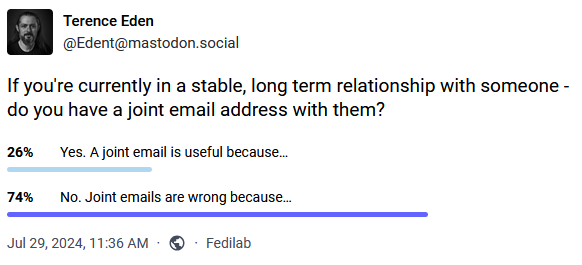
It wasn’t until after I clicked “No” that I realised that, in actual fact, I have had multiple email addresses that I’ve share with significant other(s). And more than that, sometimes they’ve been geographically-based! What’s going on?
I’ve routinely had domains or subdomains that I’ve used to represent a place that I live. They’re convenient for when you want to give somebody a short web address which’ll take them to a page with directions to you and links to your location in a variety of different services and formats.
And by that point, you might as well have an email alias, e.g. all@myhouse.example.org, that forwards on email to, well, all the adults at the house. What I’ve
described there is, after a fashion, a shared email address tied to a geographical location. But we don’t ever send anything from it. Nor do we use it for any kind of
personal communication with anybody outside the house.
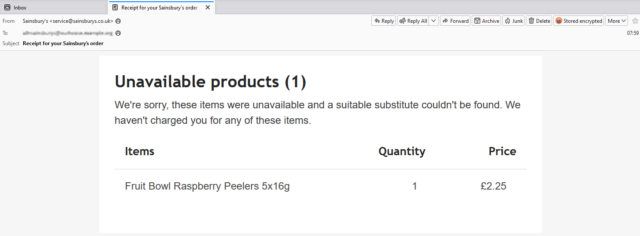
We don’t give out these all@ addresses (or their aliases: every company gets their own) to people willy-nilly. But they’re useful for shared services that send
automated emails to us all. For example:
- Giving a forwarding alias to the supermarket means that receipts (listing any unavailable products) g0 to all of us, and whoever’s meal plan’s been scuppered by an awkward substitution will know what’s up.
- Using a forwarding alias with the household Netflix account means anybody can use the “send me a sign-in link” feature to connect a new device.
- When confirming that you’ve sent money to a service provider, CC’ing one of these nice, short aliases provides a quick way to let the others know that a bill’s been paid (this one’s especially useful where, like me, you live in a 3+ adult household and otherwise you’d be having to add multiple people to the CC field).
Sure, the need for most of these solutions would evaporate instantly if more services supported multi-user or delegated access3. But outside of that fantasy world, shared aliases seem to be pretty useful!
Footnotes
1 The most ill-conceived example of geographically-based email addresses I’ve ever seen
came from a a 2003 proposal by then-MP Derek Wyatt, who proposed that the domain name part of every single email address should contain not
only the country of the owner (e.g. .uk) but also their complete postcode. He was under the delusion that this would somehow prevent spam. Even ignoring the
immense technical challenges of his proposal and the impossibility of policing it across the borders of every country that uses email… it probably wouldn’t even be
effective at his stated goal. I’ll let The Register take it from here.
2 No ageism intended: I suspect that the phenomenon actually stems from the fact that as email took off in the noughties this demographic who were significantly more-likely than younger folks to have (a) a very long-term home that they didn’t anticipate moving out of any time soon, and (b) an existing anticipation that people and companies wrote to them as a couple, not individually.
3 I’d love it if the grocery delivery sites would let multiple “accounts”, by mutual consent, share a delivery slot, destination, and payment method. It’d be cool to know that we could e.g. have a houseguest and give them temporary access to a specific order that was scheduled for during their stay. But that’s probably a lot of work for very little payoff if you’re busy running a supermarket.
Framing Device
Doors
As our house rennovations/attic conversions come to a close, I found myself up in what will soon become my en suite, fitting a mirror, towel rail, and other accessories.
Wanting to minimise how much my power tool usage disturbed the rest of the house, I went to close the door separating my new bedroom from my rest of my house, only to find that it didn’t properly fit its frame and instead jammed part-way-closed.
Somehow we’d never tested that this door closed properly before we paid the final instalment to the fitters. And while I’m sure they’d have come back to repair the problem if I asked, I figured that it’d be faster and more-satisfying to fix it for myself.
Homes
As a result of an extension – constructed long before we moved in – the house in Preston in which spent much of my childhood had not just a front and a back door but what we called the “side door”, which connected the kitchen to the driveway.
Unfortunately the door that was installed as the “side door” was really designed for interior use and it suffered for every winter it faced the biting wet North wind.

My father’s DIY skills could be rated as somewhere between mediocre and catastrophic, but his desire to not spend money “frivolously” was strong, and so he never repaired nor replaced the troublesome door. Over the course of each year the wood would invariably absorb more and more water and swell until it became stiff and hard to open and close.
The solution: every time my grandfather would visit us, each Christmas, my dad would have his dad take down the door, plane an eighth of an inch or so off the bottom, and re-hang it.
Sometimes, as a child, I’d help him do so.
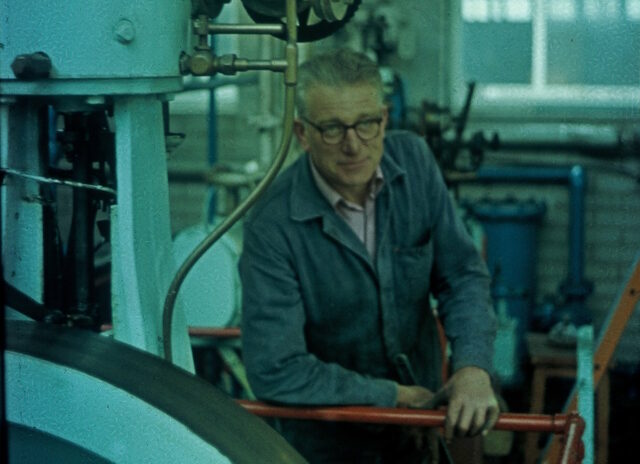
Planes
The first thing to do when repairing a badly-fitting door is work out exactly where it’s sticking. I borrowed a wax crayon from the kids’ art supplies, coloured the edge of the door, and opened and closed it a few times (as far as possible) to spot where the marks had smudged.
Fortunately my new bedroom door was only sticking along the top edge, so I could get by without unmounting it so long as I could brace it in place. I lugged a heavy fence post rammer from the garage and used it to brace the door in place, then climbed a stepladder to comfortably reach the top.
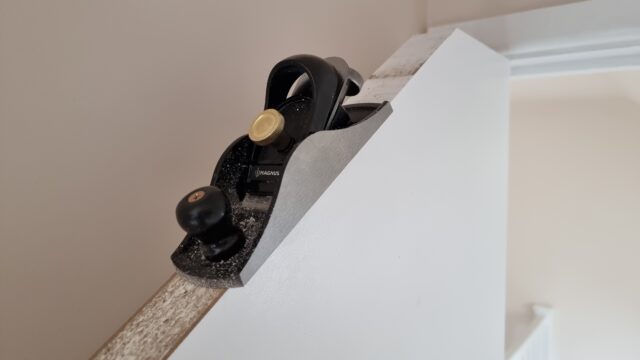
Loss
After my paternal grandfather died, there was nobody left who would attend to the side door of our house. Each year, it became a little stiffer, until one day it wouldn’t open at all.
Surely this would be the point at which he’d pry open his wallet and pay for it to be replaced?
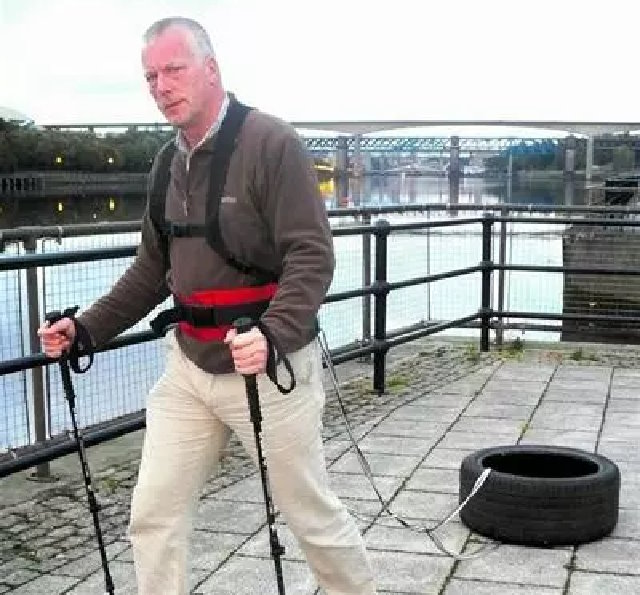
Nope. Instead, he inexpertly screwed a skirting board to it and declared that it was now no-longer a door, but a wall.
I suppose from a functionalist perspective he was correct, but it still takes a special level of boldness to simply say “That door? It’s a wall now.”
Sand
Of all the important tasks a carpenter (or in this case, DIY-er) must undertake, hand sanding must surely be the least-satisfying.
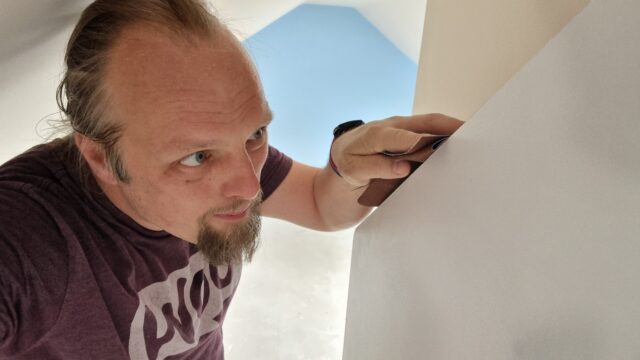
But reaching the end of the process, the feel of a freshly-planed, carefully-sanded piece of wood is fantastic. This surface represented chaos, and now it represents order. Order that you yourself have brought about.
Often, you’ll be the only one to know. When my grandfather would plane and sand the bottom edge of our house’s side door, he’d give it a treatment of oil (in a doomed-to-fail attempt to keep the moisture out) and then hang it again. Nobody can see its underside once it’s hung, and so his handiwork was invisible to anybody who hadn’t spent the last couple of months swearing at the stiffness of the door.
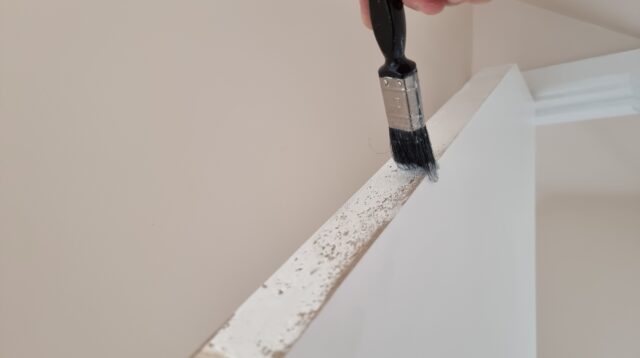
Even though the top of my door is visible – particularly visible, given its sloping face – nobody sees the result of the sanding because it’s hidden beneath a layer of paint.
A few brush strokes provide the final touch to a spot of DIY… that in provided a framing device for me to share a moment of nostalgia with you.
Sweep away the wood shavings. Keep the memories.
[Bloganuary] Traditions
This post is part of my attempt at Bloganuary 2024. Today’s prompt is:
Write about a few of your favourite family traditions.
We’ve got a wonderful diversity of family traditions. This by virtue, perhaps, of us being a three-parent family, and so bringing 50% more different traditions and 100% less decisiveness over which to accept than a traditional two-parent family. Or it might reflect our outlook and willingness to evaluate and try new things: to experiment and adopt what works. Or perhaps we just like to be just-barely on this side of the line across the the quirky/eccentric scale1.
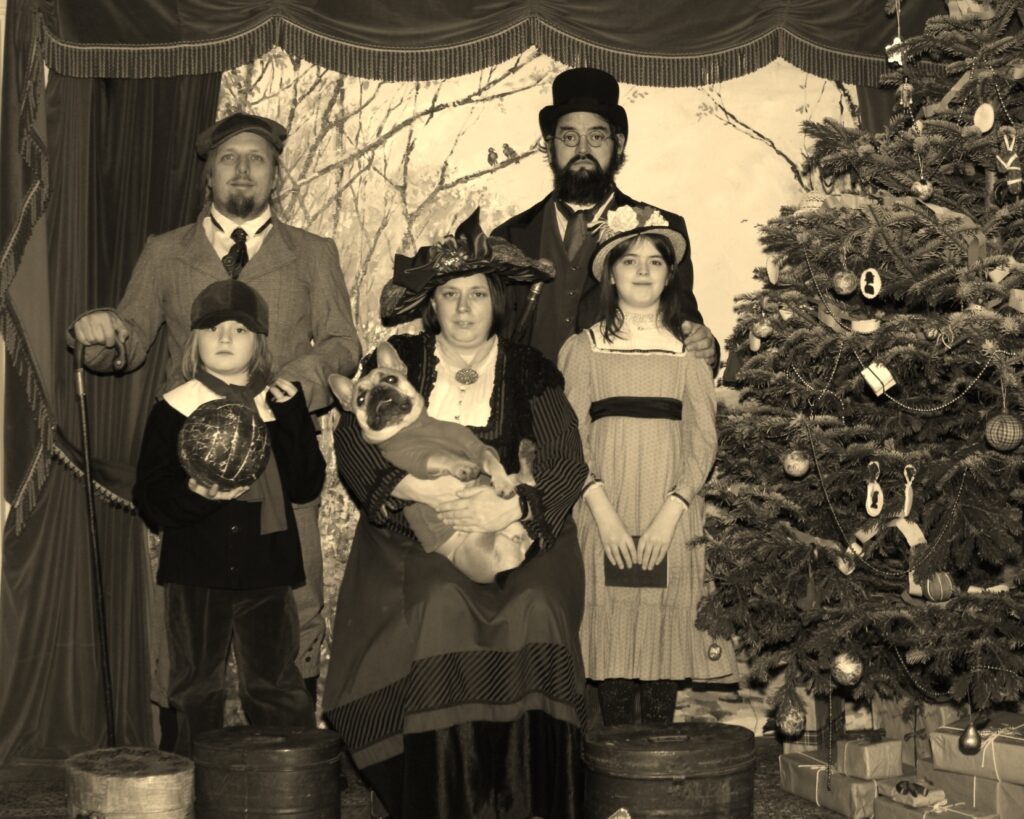
But there are plenty of other traditions we’ve inherited or created, such as:
- Pancake Brunch Sundays sort-of evolved out of a fried Sunday breakfast that used to be a household tradition many years ago. If you come visit us for a weekend you’ll find you’re served pancakes (or possibly waffles) with a mixture of traditional toppings plus, usually, a weekly “feature flavour” around midday on Sunday. For no reason now other than it’s just what we do.

- Family Day is an annual event, marked on or near 3 July each year, with gifts for children and possibly an outing or trip away for everybody to enjoy. It celebrates the fact that we get to be a family together, despite forces outside of our control trying to conspire to prevent it.2
- Family Film Night takes place most months: in rotation, the five of us take turns to nominate a film or two that we’ll all watch together along with snacks and sweet treats. It might be seen as a continuation of the pre-children tradition of Troma Night from back in the day, except that we don’t go out of our way to deliberately watch terrible films: now that happens just as a result of good or bad fortune! We also periodically schedule a Family Board Games Night, and a Family Videogames Night.

- Christmas Eve Books: a tradition we stole from Iceland is that we give books on Christmas Eve. Adults in our household now don’t really get Christmas gifts, but everybody present is encouraged to exchange books on Christmas eve and then sit up late reading together, often with gingerbread, chocolate, and/or a pan of mulled wine keeping warm on the stove. I find it a fun way to keep my reading list stocked early in the year, plus it encourages the kids to read3
- Festive meals, while I’m thinking about that end of the year, are pretty-well established. Christmas Eve is all about roast duck pancakes. Christmas Day sees me roast a goose. New Years’ Eve is for fondue. Plus vegetarian (and sometimes vegan) alternatives to the otherwise-unsuitable things, of course.
I’m certain there must be more, but the thing with family traditions is they become part of the everyday tapestry of your life after a while. Eventually traditions become hard to see them because they’re always there. I’m sure there are more “everyday rituals” that we’ve taken on that are noteworthy or interesting to outsiders but which to us are so mundane as to be unworthy of mention!
But every single one of these is something special to us. They’re an element of structure for the kids and a signifier of community to all of us. They’re routines that we’ve taken on and made “ours” as part of our collective identity as a family. And that’s just great.
Footnotes
1 Determining which side of the line I mean is left as an exercise to the reader.
2 It’s been what…? 6½ years…? And I’m still not ready even emotionally to blog about the challenges we faced, so maybe I never will. So if you missed that chapter of our lives, suffice to say: for a while, it looked like we might not get to continue being a family, and over the course of one exceptionally-difficult year it took incredible effort, resolve, sleepless nights, supportive families, and (when it came down to brass tacks) enough money and lawyers to seek justice… in order to ensure that we got to continue to be. About which we’re all amazingly grateful, and so we celebrate it.
3 Not that they need any help with that, little bookworms that they are.
[Bloganuary] Attachment
This post is part of my attempt at Bloganuary 2024. Today’s prompt is:
Describe an item you were incredibly attached to as a youth. What became of it?
I really struggled with this question: I couldn’t think of anything that I was especially attached to as a kid.

Maybe it was just that I couldn’t think of anything; that the memory was lost to time and age.
So I did the obvious thing… and reached out to my mum.

It turns out that apparently my recollection is correct: I really didn’t have any significant attachments to toys or anything like them. I didn’t ever have any kind of “special thing” I slept with. I recall in my later childhood being surprised to learn that some people did have such things: like all children, I’d internalised my experience of the world as being representative of the general state of things!
Why, I wonder, are some children different than others and get this kind of youthful attachment to something? Is it genetic?1 Is it memetic, perhaps a behaviour we subconsciously reinforce in our children because we think it’s “normal”?

I’ll bet that some clever psychologist has done some research into this already2, but that sounds like a different day’s exploration.
Footnotes
1 I’m not genetically-related to our kids: they’re biologically the children of my partner and her husband, but consider all three of us to be their parents.
2 And that a dozen other psychologists have reinterpreted this research in completely different and incompatible ways.
Normal for Children
Lacking a basis for comparison, children accept their particular upbringing as normal and representative.

Kit was telling me about how his daughter considers it absolutely normal to live in a house full of insectivorous plants1, and it got me thinking about our kids, and then about myself:
I remember once overhearing our eldest, then at nursery, talking to her friend. Our kid had mentioned doing something with her “mummy, daddy, and Uncle Dan” and was incredulous that her friend didn’t have an Uncle Dan that they lived with! Isn’t having three parents… just what a family looks like?

By the time she was at primary school, she’d learned that her family wasn’t the same shape as most other families, and she could code-switch with incredible ease. While picking her up from school, I overheard her talking to a friend about a fair that was coming to town. She told the friend that she’d “ask her dad if she could go”, then turned to me and said “Uncle Dan: can we go to the fair?”; when I replied in the affirmitive, she turned back and said “my dad says it’s okay”. By the age of 5 she was perfectly capable of translating on-the-fly2 in order to simultaneously carry out intelligble conversations with her family and with her friends. Magical.
When I started driving, and in particular my first few times on multi-lane carriageways, something felt “off” and it took me a little while to work out what it was. It turns out that I’d internalised a particular part of the motorway journey experience from years of riding in cars driven by my father, who was an unrepentant3 and perpetual breaker of speed limits.4 I’d come to associate motorway driving with overtaking others, but almost never being overtaken, but that wasn’t what I saw when I drove for myself.5 It took a little thinking before I realised the cause of this false picture of “what driving looks like”.
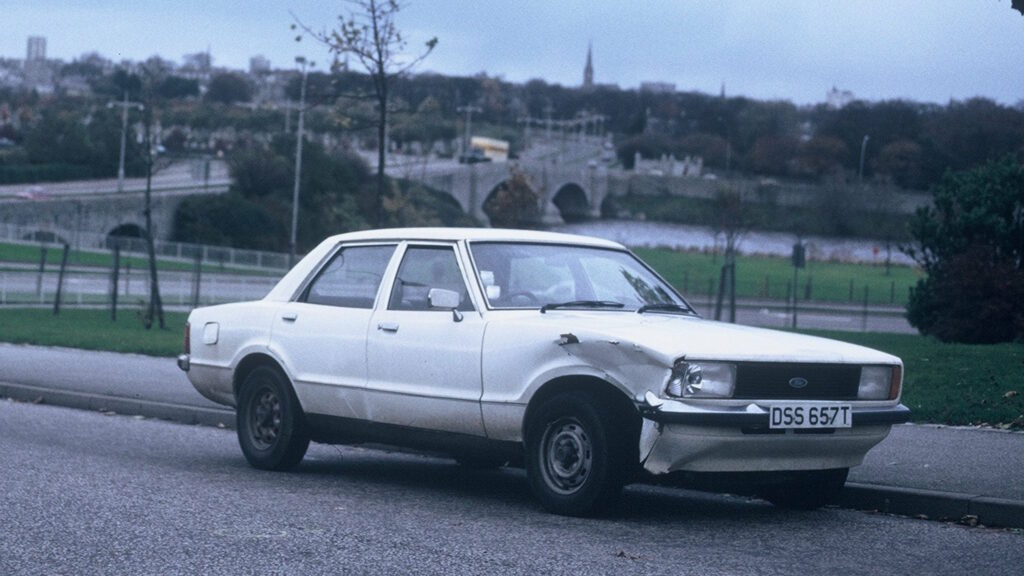
The thing is: you only ever notice the “this is normal” definitions that you’ve internalised… when they’re challenged!
It follows that there are things you learned from the quirks of your upbringing that you still think of as normal. There might even be things you’ll never un-learn. And you’ll never know how many false-normals you still carry around with you, or whether you’ve ever found them all, exept to say that you probably haven’t yet.

It’s amazing and weird to think that there might be objective truths you’re perpetually unable to see as a restult of how, or where, or by whom you were brought up, or by what your school or community was like, or by the things you’ve witnessed or experienced over your life. I guess that all we can all do is keep questioning everything, and work to help the next generation see what’s unusual and uncommon in their own lives.
Footnotes
1 It’s a whole thing. If you know Kit, you’re probably completely unsurprised, but spare a thought for the poor randoms who sometimes turn up and read my blog.
2 Fully billingual children who typically speak a different language at home than they do at school do this too, and it’s even-more amazing to watch.
3 I can’t recall whether his license was confiscated on two or three separate ocassions, in the end, but it was definitely more than one. Having a six month period where you and your siblings have to help collect the weekly shop from the supermarket by loading up your bikes with shopping bags is a totally normal part of everybody’s upbringing, isn’t it?
4 Virtually all of my experience as a car passenger other than with my dad was in Wales, where narrow windy roads mean that once you get stuck behind something, that’s how you’re going to be spending your day.
5 Unlike my father, I virtually never break the speed limit, to such an extent that when I got a speeding ticket the other year (I’d gone from a 70 into a 50 zone and re-set the speed limiter accordingly, but didn’t bother to apply the brakes and just coasted down to the new speed… when the police snapped their photo!), Ruth and JTA both independently reacted to the news with great skepticism.
Dog; Person [Video]
This post is also available as an article. So if you'd rather read a conventional blog post of this content, you can!
This video accompanies a blog post of the same title. The content is basically the same – if you prefer videos, watch this video. If you prefer blog posts, go read the blog post.
Dog; Person
This post is also available as a video. If you'd prefer to watch/listen to me talk about this topic, give it a look.
This blog post is also available as a video. Would you prefer to watch/listen to me tell you about not being a “dog person”, but still loving one dog in particular?
I am not a “dog person”. I’m probably more of a “cat person”.

My mum has made pets of one or both of dogs or cats for most of her life. She puts the difference between the two in a way that really resonates for me. To paraphrase her:
When you’re feeling down and you’ve had a shitty day and you just need to wallow in your despair for a little bit… a pet dog will try to cheer you up. It’ll jump up at you, bring you toys, suggest that you go for a walk, try to pull your focus away from your misery and bring a smile to your face. A cat, though, will just come and sit and be melancholy with you. Its demeanour just wordlessly says: “You’re feeling crap? Me too: I only slept 16 hours today. Let’s feel crap together.”
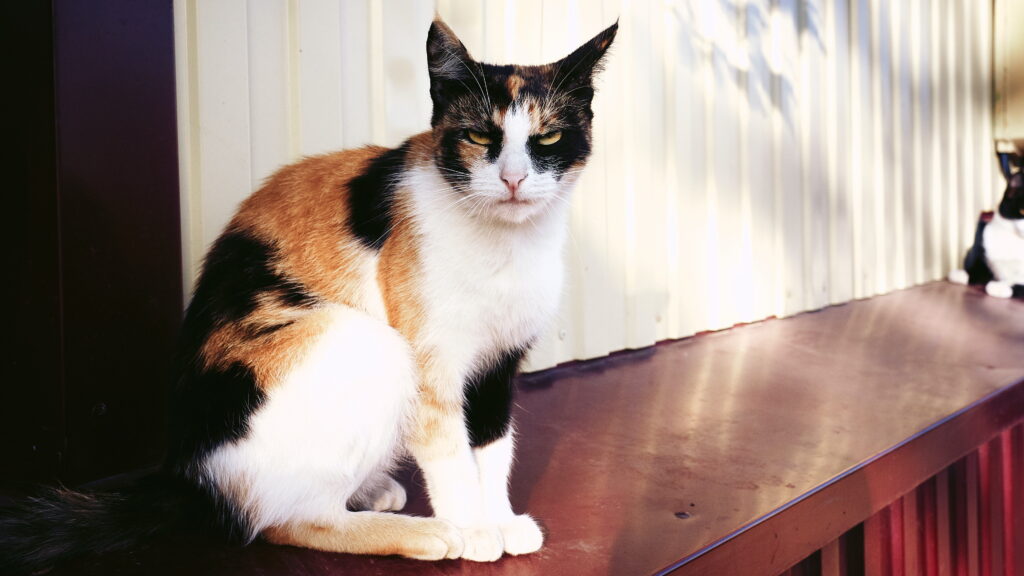
So it surprised many when, earlier this year, our family was expanded with the addition of a puppy called Demmy. I guess we collectively figured that now we’d solved all the hard problems and the complexities of our work, volunteering, parenting, relationships, money etc. and our lives were completely simple, plain sailing, and stress-free, all of the time… that we now had the capacity to handle adding another tiny creature into our midst. Do you see the mistake in that logic? Maybe we should have, too.
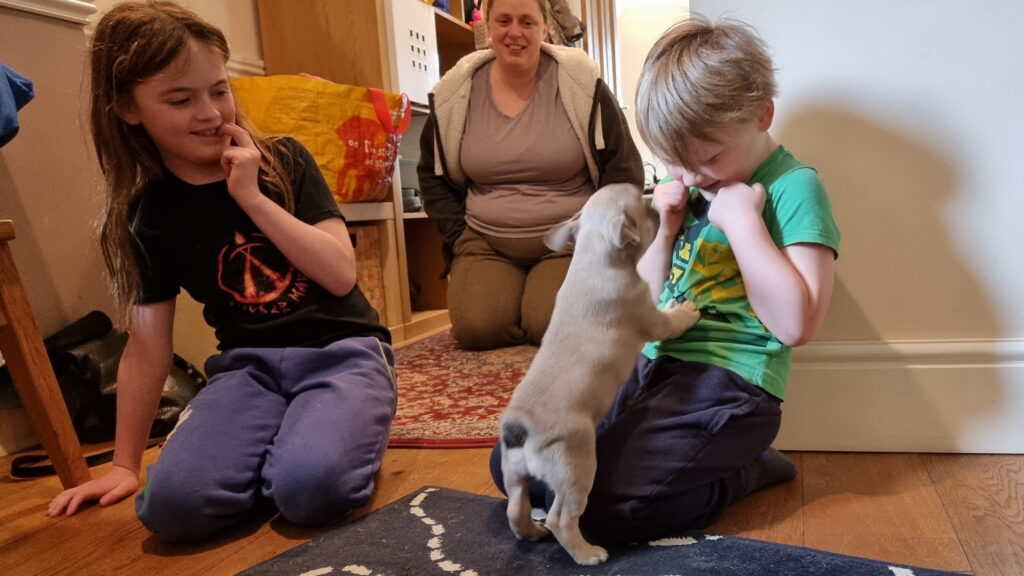
It turns out that getting a puppy is a lot like having a toddler all over again. Your life adjusts around when they need to sleep, eat, and poop. You need to put time, effort, and thought into how to make and keep your house safe both for and from them. And, of course, they bring with them a black hole that eats disposable income.

They need to be supervised and entertained and educated (the latter of which may require some education yourself). They need to be socialised so they can interact nicely with others, learn the boundaries of their little world, and behave appropriately (even when they’re not on camera).
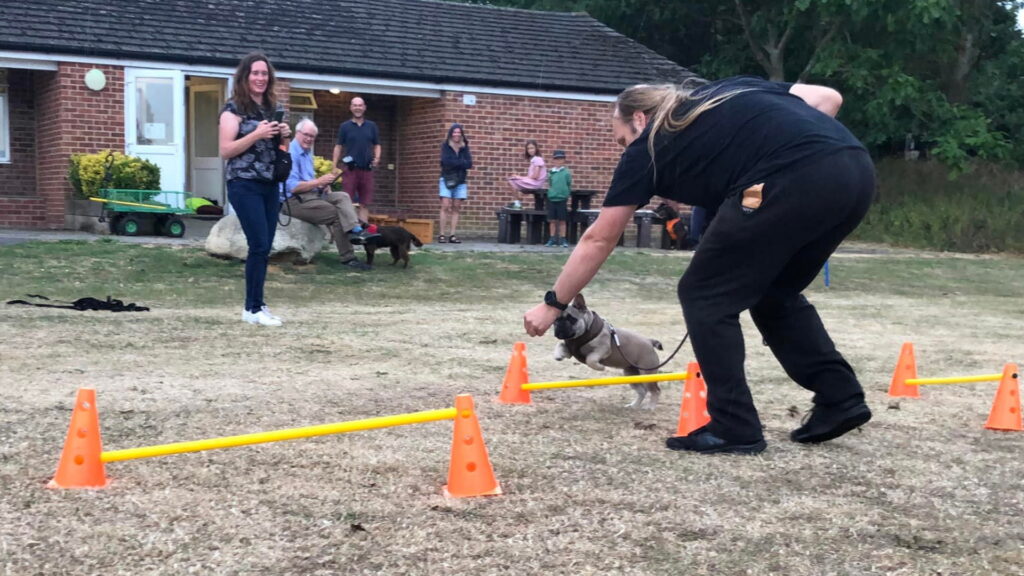
Even as they grow, their impact is significant. You need to think more-deeply about how, when and where you travel, work out who’s responsible for ensuring they’re walked (or carried!) and fed (not eaten!) and watched. You’ve got to keep them safe and healthy and stimulated. Thankfully they’re not as tiring to play with as children, but as with kids, the level of effort required is hard to anticipate until you have one.
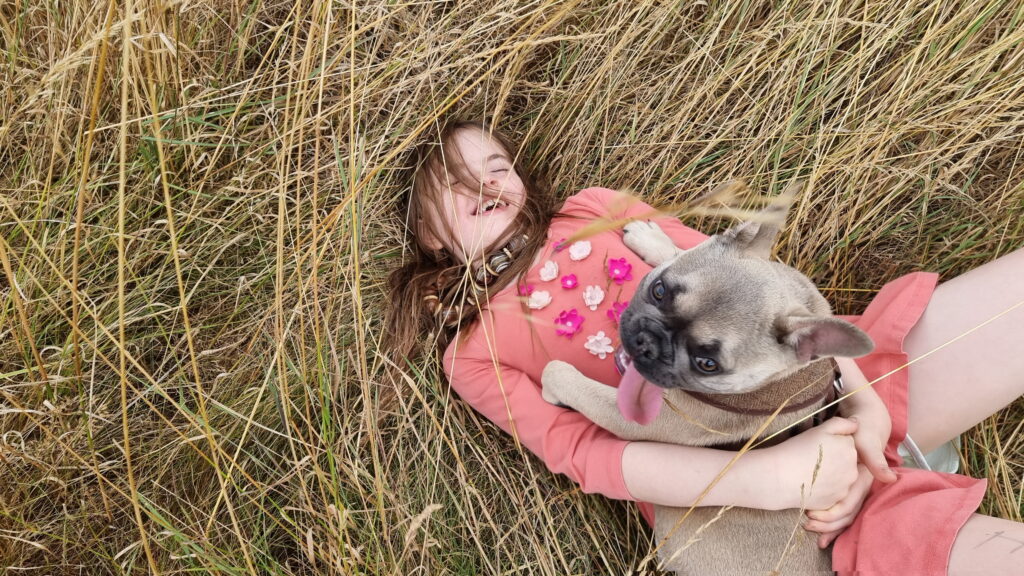
But do you know what else they have in common with kids? You can’t help learning to love them.
It doesn’t matter what stupid thing they’re illicitly putting in their mouth, how many times you have to clean up after them, how frustrating it is that they can’t understand what you need from them in order to help them, or how much they whine about something that really isn’t that big a deal (again: #PuppyOrToddler?). It doesn’t even matter how much you’re “not a dog person”, whatever that means. They become part of your family, and you fall in love with them.
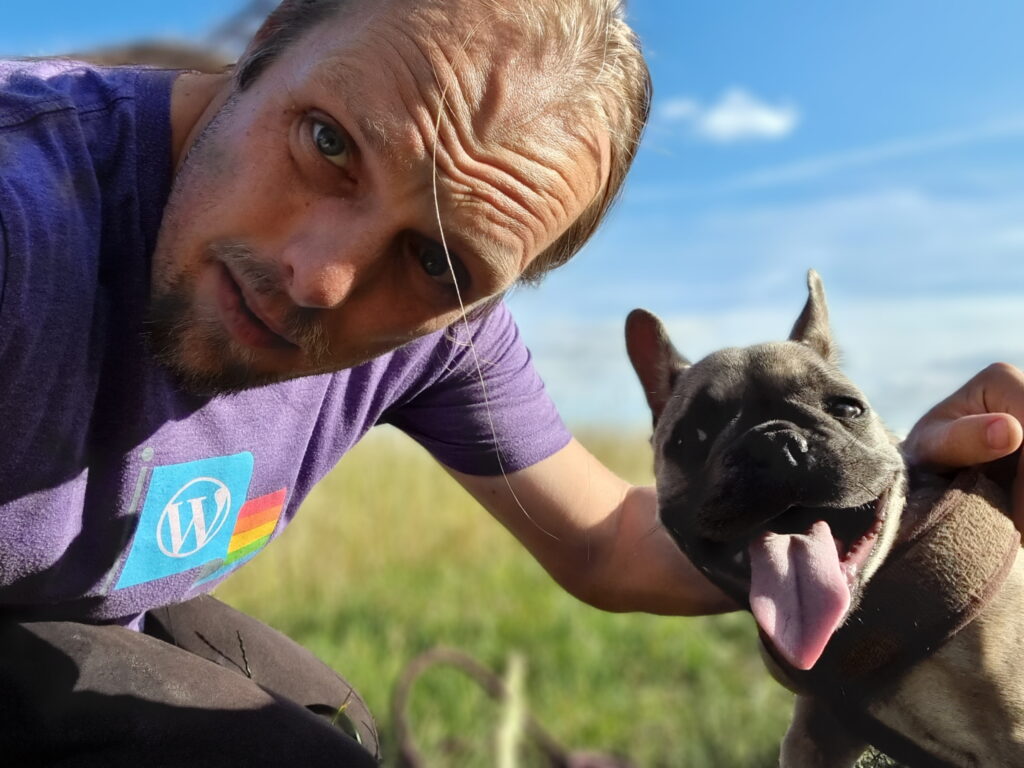
I’m not a “dog person”. But: while I ocassionally resent the trouble she causes, I still love our dog.
